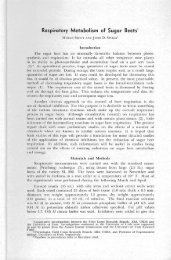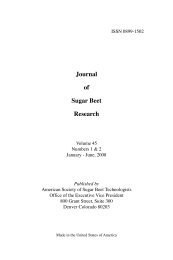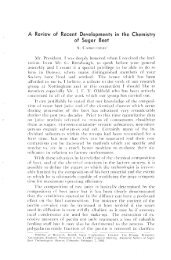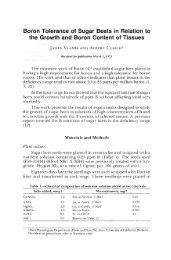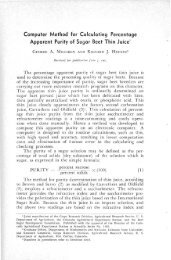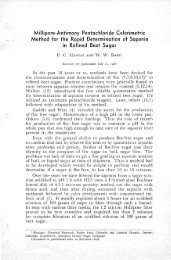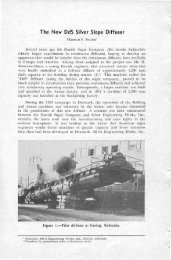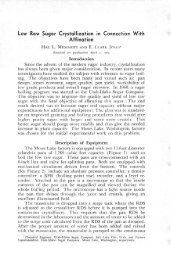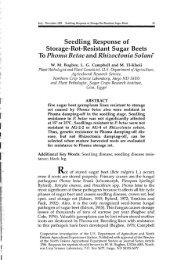Colorimetric Micro Determination of Calcium In Sugar-House ... - Vol
Colorimetric Micro Determination of Calcium In Sugar-House ... - Vol
Colorimetric Micro Determination of Calcium In Sugar-House ... - Vol
You also want an ePaper? Increase the reach of your titles
YUMPU automatically turns print PDFs into web optimized ePapers that Google loves.
<strong>Colorimetric</strong> <strong>Micro</strong> <strong>Determination</strong> <strong>of</strong> <strong>Calcium</strong> <strong>In</strong><br />
<strong>Sugar</strong>-<strong>House</strong> Products<br />
G. V. HEYNDRICKX'<br />
<strong>In</strong>troduction<br />
The quantitative estimation <strong>of</strong> calcium in sugar-house products,<br />
SLlch as raw juice, clarified juice, syrup, molasses and raw<br />
sugar is very important in sugar manufacturing. Many methods<br />
for this estimation exist in the literature p Ointing to the importance<br />
<strong>of</strong> the calcium content, but also to the complexity<br />
<strong>of</strong> the problem. Since the standard analytical oxalate method<br />
is cumbersome, m any routine methods have been proposed. The<br />
eldest <strong>of</strong> these is the soap mcrhod <strong>of</strong> Spengler and Brendel (4)"<br />
which gives an estimate <strong>of</strong> the total quantity <strong>of</strong> calcium and<br />
magnesium, with doubtful accuracy, however.<br />
Several workers have developed in recent years more elegant<br />
methods based on the EDTA (ethylenediamine tetra acetate) reaction.<br />
<strong>In</strong> these methods the sugar solution is titrated with a<br />
solution <strong>of</strong> EDTA in the presence <strong>of</strong> eriochrome black [Honig<br />
(1), Saunier and Lemaitre (3)] . The amount <strong>of</strong> EDTA employed<br />
is a measure <strong>of</strong> the calcium plus magnesium content. v\Then the<br />
calcium content is desired, a second titration is carried out on<br />
the sugar solution after precipitation <strong>of</strong> the calcium, or another<br />
indicator such as murexide [Ramaiah, Vishnu and Chaturvedi<br />
(2)] is used, which, however, requires a photometr ic titration<br />
apparatus. The great disadvantage <strong>of</strong> the EDTA titrations, even<br />
with a photometer, is the troubles which occur on examining<br />
stark colored solutions like raw juice and molasses. It is significant<br />
that in the 1964 edition <strong>of</strong> the IClTMSA methods <strong>of</strong><br />
sugar analysis, a method ror determination <strong>of</strong> calcium is not<br />
mentioned.<br />
The present communication reports a simple, sensitive and<br />
accurate method for estimation <strong>of</strong> ca lcium, which is elaborate<br />
by Trinder (5) for blood, but so far is not applied to sugarhoust:<br />
products.<br />
Materials and Methods<br />
<strong>In</strong> the proposed hydroxamate m ethod, the calcium is precipitated<br />
as its naph-thalhydroxamate. After centrifugation, the<br />
unwashed precipitate is dissolved and the color intensity <strong>of</strong> the<br />
1 State Agricultural University, Gent, Belgium.<br />
=? Numbers in parentheses refer to literatu re cited.
682 JOURNAL OF THE A. S. S. B. T.<br />
obtained solution after addition <strong>of</strong> ferric nitrate is measured 111<br />
a simple colorimeter.<br />
Reagents-<strong>Calcium</strong> reagent solution made by dissolving<br />
(under heat) 20 mg naph-thalhydroxamic acid in ]00 ml <strong>of</strong> water<br />
containing 5 ml or ethanolamine and 2g <strong>of</strong> D tartaric acid.<br />
After cooling, 9g <strong>of</strong> sodiumchloride dissolved in water is added<br />
and diluted with water to 1 liter.<br />
Alkalin solution is made by dissolving 2g EDT.\. (disodiumsalt)<br />
in 1 liter <strong>of</strong> 0.1 N sodium hydroxide.<br />
Color solution is made by dissolving 60g ferric nitrate nine<br />
hydrate in 1 liter <strong>of</strong> water containing 15 ml nitric acid (D = 1.4).<br />
Standard <strong>Calcium</strong> solution is made by dissolving 100.1 mg<br />
analytical reagent dry cakiumcarbonate in 0.1 :\J hydrochloric<br />
acid and diluting to 1 liter with water.<br />
Procedure-0.5 ml <strong>of</strong> sugar solution is mixed in a centrifuge<br />
tube with 5 ml <strong>of</strong> calcium reagent solution and after 30 minutes<br />
is spun in an ordinary laboratory centrifuge for 5 minutes.<br />
The supernatant liquid is carefully poured <strong>of</strong>f and, while the<br />
tu be is still inverted, it is placed in a rack to drain on filter<br />
paper. After a few minutes, the mouth <strong>of</strong> the tube is wiped<br />
dry with filter paper and 1 ml <strong>of</strong> alkaline solution is added.<br />
The tube is covered with a glass stop or an aluminium cap and<br />
heated in a boiling waterbath, shaking the tube at intervals to<br />
ensure complete solution <strong>of</strong> the precipitate. After 10 minutes,<br />
the tube is removed and when cool 3 ml <strong>of</strong> the color solution<br />
is added and the content <strong>of</strong> the tube m.ixed. The optical density<br />
<strong>of</strong> the solution is then measured at 450 m,u against a blank prepared<br />
hy carrying out the same procedure, but with omission<br />
<strong>of</strong> the sugar solution. The calcium content <strong>of</strong> the sugar solution<br />
is calculated from a graph, obtained with standard calcium solutions<br />
containing' 4 to 40 ,ug calcium in the 0.5 ml, analyzed together<br />
with the test.<br />
The above procedure is carried out on undiluted raw and<br />
clarified juices, while syrup and molasses samples were diluted<br />
to a concentration <strong>of</strong> about 20 ,ug calcium in 0.5 ml. <strong>In</strong> order<br />
to study the possible influence <strong>of</strong> organic matter and complexes,<br />
the above procedure is simultaneously carried out on the samples<br />
after digestion with a mixture o( concentrated nitric acid and<br />
perchloric acid.<br />
The results obtained with the hydroxamate method were<br />
compared 'with those obtained with the standard oxalate method.<br />
Herewith, the calcium in the sugar solution, digested or not,<br />
is precipitated at pH 5 with saturated ammonium oxalate. After
686 JOURNAL OF THE A. S. S. B. T.<br />
gives no significantly different results in comparison with the<br />
standard oxalate method and with practical equal precision or<br />
reproducibility. Since the hydroxamate method is more sensitive<br />
and less time consuming than the oxalate or complexometric<br />
method and can be carried out directly on the samples 'without<br />
digestion or defecation, even on raw juices or molasses, it is a<br />
reliable and convenient method, which can be successfully applied<br />
in the sugar industry.<br />
Literature Cited<br />
(1) HONIG, P. 1952. <strong>Calcium</strong> and magnesium 111 cane juices and sugars.<br />
Repts. ,,,Test <strong>In</strong>dies <strong>Sugar</strong> Corp. N o. 2.<br />
(2) RAMAIAH, N ..\., VISHNU and R. K. CHATURVEDJ. 1958. A simple<br />
method for estimation <strong>of</strong> calcium in technical sugar solutions using<br />
ethylenediamine tetraacetic acid. Sharblra, 1: 124-136.<br />
(3) SAUNIER, R. and A. LEilIAITRE. 1951. Dosage volumetrique de calcium<br />
et du magnesium clans les jus de sucrerie. Suer. frilne. 92: 231-233.<br />
(4) SPENGLER, O. and C. BRENDEL. 1928. Die Kalkbestimmung in Zuckerfabrikproclukten.<br />
Z. Ver. Dtsch. Zuckerind. 78: 175-189.<br />
(5) TRINDER, P. 1960. <strong>Colorimetric</strong> micro-cletermina(ion <strong>of</strong> cal c i u rn i 11<br />
serum. Analyst 85: 889-894.



